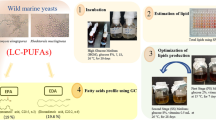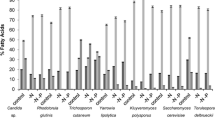Abstract
Tailoring lipids from oleaginous yeasts to contain specific types of fatty acid is of considerable interest to food, fuel, and pharmaceutical industries. In this study, the essential oil obtained from Citrus sinesus L. has been used to alter the fatty acid composition of two common oleaginous yeasts, Rhodosporidium toruloides and Cryptococcus curvatus. With increasing levels of essential oil in the medium, the metabolic flux of the fatty acid biosynthesis pathway shifted towards saturated fatty acid production. Essential oil reduced the activities of elongase and ∆9 desaturase. This made the lipid obtained from both these yeasts rich in saturated fatty acids. At certain specific concentrations of the essential oil in the medium, the lipid obtained from R. toruloides and C. curvatus cultures was similar to mahuwa butter and palm oil, respectively. Limonene is the major constituents of orange essential oil. Its effect on one of the oleaginous yeasts, R. toruloides, was also studied separately. Effects similar to orange essential oil were obtained with limonene. Thus, we can conclude that limonene in orange essential oil brings about compositional change of microbial lipid produced in this organism.



Similar content being viewed by others
References
Uprety, B. K., Chaiwong, W., Ewelike, C., & Rakshit, S. K. (2016). Biodiesel production using heterogeneous catalysts including wood ash and the importance of enhancing byproduct glycerol purity. Energy Conversion and Management, 115, 191–199. doi:10.1016/j.enconman.2016.02.032.
Uprety, B. K., Dalli, S. S., & Rakshit, S. K. (2017). Bioconversion of crude glycerol to microbial lipid using a robust oleaginous yeast Rhodosporidium toruloides ATCC 10788 capable of growing in the presence of impurities. Energy Conversion and Management, 135, 117–128. doi:10.1016/j.enconman.2016.12.071.
Christophe, G., Kumar, V., Nouaille, R., Gaudet, G., Fontanille, P., Pandey, A., Soccol, C. R., & Larroche, C. (2012). Recent developments in microbial oils production: a possible alternative to vegetable oils for biodiesel without competition with human food? Brazilian Archives of Biology and Technology, 55(1), 29–46. doi:10.1590/S1516-89132012000100004.
Moustogianni, A., Bellou, S., Triantaphyllidou, I., & Aggelis, G. (2014). Recent developments in microbial oils production: a possible alternative to vegetable oils for biodiesel without competition with human food? Environmental Biotechnology, 10(1), 1–7. doi:10.14799/ebms237.
Xu, J., Zhao, X., Wang, W., Du, W., & Liu, D. (2012). Microbial conversion of biodiesel byproduct glycerol to triacylglycerols by oleaginous yeast Rhodosporidium toruloides and the individual effect of some impurities on lipid production. Biochemical Engineering Journal, 65, 30–36. doi:10.1016/j.bej.2012.04.003.
Pyle, D. J., Garcia, R. A., & Wen, Z. (2008). Producing docosahexaenoic acid (DHA)-rich algae from biodiesel-derived crude glycerol: effects of impurities on DHA production and algal biomass composition. Journal of Agricultural and Food Chemistry, 56(11), 3933–3939. doi:10.1021/jf800602s.
Cao, Y., Liu, W., Xu, X., Zhang, H., Wang, J., & Xian, M. (2014). Production of free monounsaturated fatty acids by metabolically engineered Escherichia coli. Biotechnology for Biofuels, 7(1), 59. doi:10.1186/1754-6834-7-59.
Lipp, M., Simoneau, C., Ulberth, F., Anklam, E., Crews, C., Brereton, P., Greyt, W., Schwack, W., & Wiedmaier, C. (2001). Composition of genuine cocoa butter and cocoa butter equivalents. Journal of Food Composition and Analysis, 14(4), 399–408. doi:10.1006/jfca.2000.0984.
Papanikolaou, S., Gortzi, O., Margeli, E., Chinou, I., Galiotou-Panayotou, M., & Lalas, S. (2008). Effect of citrus essential oil addition upon growth and cellular lipids of Yarrowia lipolytica yeast. European Journal of Lipid Science and Technology, 110(11), 997–1006. doi:10.1002/ejlt.200800085.
Sitepu, I. R., Sestric, R., Ignatia, L., Levin, D., German, J. B., Gillies, L. A., Almada, L. A. G., & Boundy-Mills, K. L. (2013). Manipulation of culture conditions alters lipid content and fatty acid profiles of a wide variety of known and new oleaginous yeast species. Bioresource Technology, 144, 360–369. doi:10.1016/j.biortech.2013.06.047.
Moustogianni, A., Bellou, S., Triantaphyllidou, I., & Aggelis, G. (2015). Feasibility of raw glycerol conversion into single cell oil by zygomycetes under non-aseptic conditions. Biotechnology and Bioengineering, 112(4), 827–831. doi:10.1002/bit.25482.
Burt, S. (2004). Essential oils: their antibacterial properties and potential applications in foods—a review. International Journal of Food Microbiology, 94, 223–253. doi:10.1016/j.ijfoodmicro.2004.03.022.
Bakkali, F., Averbeck, S., Averbeck, D., & Idaomar, M. (2008). Biological effects of essential oils—a review. Food and Chemical Toxicology, 46(2), 446–475. doi:10.1016/j.fct.2007.09.106.
Ghfir, B., Fonvieille, J. L., Koulali, Y., Ecalle, R., & Dargent, R. (1994). Effects of Cymbopogon citratus L. essential oil on the growth, morphogenesis and aflatoxin production of Aspergillus flavus ML2-strain. Mycopathologia, 126(3), 163–167 Retrieved fromhttp://www.ncbi.nlm.nih.gov/pubmed/7935731.
Helal, G. A., Sarhan, M. M., Abu Shahla, A. N. K., & Abou El-Khair, E. K. (2007). Journal of Basic Microbiology, 47(1), 5–15. doi:10.1002/jobm.200610137.
Aggelis, G., & Komaitis, M. (1999). Enhancement of single cell oil production by Yarrowia lipolytica growing in the presence of Teucrium polium L. aqueous extract. Biotechnology Letters, 21(9), 747–749. doi:10.1023/A:1005591127592.
Li, Y. H., Liu, B., Zhao, Z. B., & Bai, F. W. (2006). Optimized culture medium and fermentation conditions for lipid production by Rhodosporidium toruloides. Chinese Journal of Biotechnology, 22(4), 650–656 Retrieved from http://www.ncbi.nlm.nih.gov/pubmed/16894904.
Hassan, M., Blanc, P. J., Granger, L.-M., Pareilleux, A., & Goma, G. (1996). Influence of nitrogen and iron limitations on lipid production by Cryptococcus curvatus grown in batch and fed-batch culture. Process Biochemistry, 31(4), 355–361. doi:10.1016/0032-9592(95)00077-1.
Yu, X., Zheng, Y., Xiong, X., & Chen, S. (2014). Co-utilization of glucose, xylose and cellobiose by the oleaginous yeast Cryptococcus curvatus. Biomass and Bioenergy, 71, 340–349. doi:10.1016/j.biombioe.2014.09.023.
Wiebe, M. G., Koivuranta, K., Penttilä, M., & Ruohonen, L. (2012). Lipid production in batch and fed-batch cultures of Rhodosporidium toruloides from 5 and 6 carbon carbohydrates. BMC Biotechnology, 12(1), 26. doi:10.1186/1472-6750-12-26.
Gong, Z., Shen, H., Zhou, W., Wang, Y., Yang, X., & Zhao, Z. K. (2015). Efficient conversion of acetate into lipids by the oleaginous yeast Cryptococcus curvatus. Biotechnology for Biofuels, 8(1), 189. doi:10.1186/s13068-015-0371-3.
Fei, Q., O’Brien, M., Nelson, R., Chen, X., Lowell, A., & Dowe, N. (2016). Enhanced lipid production by Rhodosporidium toruloides using different fed-batch feeding strategies with lignocellulosic hydrolysate as the sole carbon source. Biotechnology for Biofuels, 9(1), 130. doi:10.1186/s13068-016-0542-x.
Liang, Y., Jarosz, K., Wardlow, A. T., Zhang, J., & Cui, Y. (2014). Lipid production by Cryptococcus curvatus on hydrolysates derived from corn fiber and sweet sorghum bagasse following dilute acid pretreatment. Applied Biochemistry and Biotechnology, 173(8), 2086–2098. doi:10.1007/s12010-014-1007-y.
Ling, J., Nip, S., & Shim, H. (2013). Enhancement of lipid productivity of Rhodosporidium toruloides in distillery wastewater by increasing cell density. Bioresource Technology, 146, 301–309. doi:10.1016/j.biortech.2013.07.023.
Chi, Z., Zheng, Y., Jiang, A., & Chen, S. (2011). Lipid production by culturing oleaginous yeast and algae with food waste and municipal wastewater in an integrated process. Applied Biochemistry and Biotechnology, 165(2), 442–453. doi:10.1007/s12010-011-9263-6.
Liang, Y., Cui, Y., Trushenski, J., & Blackburn, J. W. (2010). Converting crude glycerol derived from yellow grease to lipids through yeast fermentation. Bioresource Technology, 101(19), 7581–7586. doi:10.1016/j.biortech.2010.04.061.
Meesters, P. A. E. P., Huijberts, G. N. M., & Eggink, G. (1996). High-cell-density cultivation of the lipid accumulating yeast Cryptococcus curvatus using glycerol as a carbon source. Applied Microbiology and Biotechnology, 45(5), 575–579. doi:10.1007/s002530050731.
Bligh, E. G., & Dyer, W. J. (1959). A rapid method of total lipid extraction and purification. Canadian Journal of Biochemistry and Physiology, 37(8) Retrieved from http://www.nrcresearchpress.com/doi/pdf/10.1139/o59-099.
Ichihara, K., & Fukubayashi, Y. (2010). Preparation of fatty acid methyl esters for gas-liquid chromatography. Journal of Lipid Research, 51(3), 635–640. doi:10.1194/jlr.D001065.
Matasyoh, J. C., Wagara, I. N., Nakavuma, J. L., & Kiburai, A. M. (2011). Chemical composition of Cymbopogon citratus essential oil and its effect on mycotoxigenic Aspergillus species. African Journal of Food Science, 5(3), 138–142.
Helal, G. A., Sarhan, M. M., Abu Shahla, A. N. K., & Abou El-Khair, E. K. (2006). Effects of Cymbopogon citratus L. essential oil on the growth, lipid content and morphogenesis of Aspergillus niger ML2-strain. Journal of Basic Microbiology, 46(6), 456–469. doi:10.1002/jobm.200510106.
Helal, G. A., Sarhan, M. M., Abu Shahla, A. N. K., & Abou El-Khair, E. K. (2006). Effect of Cymbopogon citratus L. essential oil on growth and morphogenesis of Saccharomyces cerevisiae ML2-strain. Journal of Basic Microbiology, 46(5), 375–386. doi:10.1002/jobm.200510084.
Verzera, A., Trozzi, A., Dugo, G., Di Bella, G., & Cotroneo, A. (2004). Biological lemon and sweet orange essential oil composition. Flavour and Fragrance Journal, 19(6), 544–548. doi:10.1002/ffj.1348.
Gao, Z., Ma, Y., Wang, Q., Zhang, M., Wang, J., & Liu, Y. (2016). Effect of crude glycerol impurities on lipid preparation by Rhodosporidium toruloides yeast 32489. Bioresource Technology, 218, 373–379. doi:10.1016/j.biortech.2016.06.088.
Abghari, A., & Chen, S. (2014). Yarrowia lipolytica as an oleaginous cell factory platform for production of fatty acid-based biofuel and bioproducts. Frontiers in Energy Research, 2, 1–21. doi:10.3389/fenrg.2014.00021.
Thevenieau, F., Beopoulos, A., Desfougeres, T., Sabirova, J., Albertin, K., Zinjarde, S., & Nicaud, J.-M. (2010). Uptake and assimilation of hydrophobic substrates by the oleaginous yeast Yarrowia lipolytica. In Handbook of hydrocarbon and lipid microbiology (pp. 1513–1527). Berlin, Heidelberg: Springer Berlin Heidelberg. doi:10.1007/978-3-540-77587-4_104.
Beopoulos, A., & Nicaud, J. M. (2012). Yeast: a new oil producer? Oléagineux, Corps Gras Lipides, 19(1), 22–28. doi:10.1051/ocl.2012.0426.
Beopoulos, A., Nicaud, J. M., & Gaillardin, C. (2011). An overview of lipid metabolism in yeasts and its impact on biotechnological processes. Applied Microbiology and Biotechnology, 90(4), 1193–1206. doi:10.1007/s00253-011-3212-8.
Moreton, R. S. (1985). Modification of fatty acid composition of lipid accumulating yeasts with cyclopropene fatty acid desaturase inhibitors. Applied Microbiology and Biotechnology, 22, 41–45.
Shimizu, S., Akimoto, K., Shinmen, Y., Kawashima, H., Sugano, M., & Yamada, H. (1991). Sesamin is a potent and specific inhibitor of Δ5 desaturase in polyunsaturated fatty acid biosynthesis. Lipids, 26(7), 512–516. doi:10.1007/BF02536595.
Rodrigues, G., & Pais, C. (2000). The influence of acetic and other weak carboxylic acids on growth and cellular death of the yeast Yarrowia lipolytica. Food Technology and Biotechnology, 38(1), 27–32.
Hiwale, S. (2015). Mahua (Bassia latifolia Roxb.) In Sustainable horticulture in semiarid dry lands (pp. 255–261). New Delhi: Springer India. doi:10.1007/978-81-322-2244-6_18.
Awasthi, Y. C., Bhatnagar, S. C., Mitra, C. R., & Mitra1, C. R. (n.d.). Chemurgy of sapotaceous plants: Madhuca species of India. Source: Economic Botany, 29(4), 380–389.
Tiwari, S., Saxena, M., & Tiwari, S. K. (2002). Preparation and characterization of penta alkyds based on mahua oil. Journal of Scientific and Industrial Research, 61(2), 110–116.
Ramadan, M. F., Sharanabasappa, G., Parmjyothi, S., Seshagiri, M., & Moersel, J. T. (2006). Profile and levels of fatty acids and bioactive constituents in mahua butter from fruit-seeds of buttercup tree [Madhuca longifolia (Koenig)]. European Food Research and Technology, 222(5–6), 710–718. doi:10.1007/s00217-005-0155-2.
Ramadan, M. F., & Moersel, J.T. (2016). Mowrah butter: nature's novel fat. Inform, 17(2).
Panda, H. (2002). Bassia latifolia, Roxb. In H. Panda (Ed.), Medicinal plants cultivation & their uses. Delhi: Asia Pacific Business Press Inc. Retrieved from https://books.google.ca/books?id=xGZNGMTyjOMC&pg=PA218&lpg=PA218&dq=bassia+latifolia+oil+medicinal+use&source=bl&ots=Msco2zHls1&sig=1IvLBEGheGRbRvlHd38DJIiaEpQ&hl=en&sa=X&ved=0ahUKEwja--riqaHPAhVn5oMKHc6CAjoQ6AEILzAD#v=onepage&q=bassia%2520latifolia%2520oil%252.
Hadadare, M., & Salunkhe, V. (2013). Simultaneous estimation of beta sitosterol and palmitic acid from methanolic extract of Caralluma adscedens var fimbriata by UV spectrophotometry. Research Journal of Pharmaceutical, Biological and Chemical Sciences, 4(3), 225–232.
Rustaiyan, A., Samiee, K., & Vahedi, M. (2012). Lipid content and fatty acid composition in muscle tissue of Perca fluviatilis in the south of the Caspian Sea. Journal of American Science, 8(11), 2000–2003.
Mancini, A., Imperlini, E., Nigro, E., Montagnese, C., Daniele, A., Orru, S., & Buono, P. (2015). Biological and nutritional properties of palm oil and palmitic acid: effects on health. Molecules, 20(9), 17339–17361. doi:10.3390/molecules200917339.
Gunstone, F. (1996). Fatty acid and lipid chemistry. Fatty acid and lipid chemistry, 2–3.
Acknowledgements
We would like to express our gratefulness to all the members of Lakehead University Centre for Analytical Services Environmental Laboratory and Lakehead University Instrumentation Laboratory (LUCAS) who helped us carry out certain analysis required as a part of this work. The authors would also like to acknowledge the support of Canada Foundation of Innovation (CFI) and Natural Sciences and Engineering Research Council of Canada (NSERC) for their financial support to undertake the PhD work in this area.
Author information
Authors and Affiliations
Corresponding author
Rights and permissions
About this article
Cite this article
Uprety, B.K., Rakshit, S.K. Compositional Shift in Fatty Acid Profiles of Lipids Obtained from Oleaginous Yeasts upon the Addition of Essential Oil from Citrus sinensis L.. Appl Biochem Biotechnol 183, 1158–1172 (2017). https://doi.org/10.1007/s12010-017-2490-8
Received:
Accepted:
Published:
Issue Date:
DOI: https://doi.org/10.1007/s12010-017-2490-8




